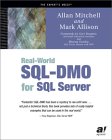My technical skills
My favorites
My picture album
Shortcut keys
My code library
VB resources
SQLServer resources
SQLServer books
Replication FAQ
Scripting resources
ASP resources
Search my site
Sign my guestbook
Contact information
|
This month's 2 click survey: Is .NET important for a database professional? |
SQL Server Articles New
|
Click here to find out the top 15 SQL Server books purchased by this site's visitors! NEW |
Featured Book:

|
Click here to read a sample chapter from the book: SQL Server Security Distilled |
| Want to keep in touch with the latest in SQL Server world? Email vyaskn@hotmail.com with 'subscribe' in the subject line |

Book Review: SQL Server 2000 for the Oracle DBA
by Chris Kempster
Click here for more information, sample chapters, or to purchase this e-book.
Since the release of version 7.0, Microsoft SQL Server has come a long way and has been gaining the RDBMS market share and consistently beating Oracle in TPC benchmarks. The ease of use, great feature set, robust engine of SQL Server 2000 meant that more and more shops are migrating to SQL Server and many new organizations are going ahead with SQL Server deployments. Today, some of the world's largest sites are running on SQL Server.
This rapid growth of SQL Server is forcing non-SQL Server DBAs to learn SQL Server to keep their jobs and to improve the marketability of their skills. This is where this new ebook "SQL Server 2000 for the Oracle DBA" comes in very handy. The author Chris has expertise in both SQL Server and Oracle, and this book concentrates on SQL Server 2000 features, from an Oracle DBA's point of view.
This book concentrates on the architectural differences between Oracle and SQL Server, and helps the Oracle DBA get upto speed with SQL Server 2000. It also covers key aspects of an RDBMS like transactions, locking, installation, backup and recovery, tools etc.
Overall, this is a great book for Oracle DBAs trying to learn and get upto speed with SQL Server 2000 and serves as a good reference to any SQL Server DBA. Since this is an ebook (in PDF format) you can simply store it on your laptop and look it up when in doubt. At about 360 pages, this is a very concise, to-the-point book and it's just $20, about half the cost of any SQL Server DBA book. Here is a list of chapters from this books:
SQL Server architecture 101:
Covers instances, memory structures, connections, extended stored procedures, checkpoint, background processes, storage engine and relational engine.
Installation:
Covers editions and versions, licensing schemes, installation in detail, and moving databases.
GUI and command line tools:
Covers all the tools that get installed along with SQL Server. Compares and contrast the equivalent Oracle tools and features.
Backup and recovery:
Covers different types of backups available in SQL Server, along with a good discussion of recovery models provided by SQL Server. Discusses recovering and restoring databases along with examples and talks about database maintenance plans.
Transactions and locking:
Discusses SQL Server transaction architecture, undo, redo management, locking and isolation levels, troubleshooting locking and deadlocking issues.
Performance tuning:
Shows you how to use SQL Server Profiler, performance monitor and other tracing mechanisms. Covers trace flags, indexing, and some general coding tips.
High availability:
Talks about SQL Server clustering, logshipping, federated databases and load balancing.
Globalisation services (NLS):
Compares the SQL Server and Oracle architecture and discusses SQL Server collations.
OLAP:
Explains the OLAP terminology, discusses the technology in detail. Covers ADO MD and DSO.
Scripts & scheduled jobs:
Covers tools like ISQL, OSQL, DTS and provides some VB, COM examples.
Managing databases:
Covers database checking routines, linked servers, DTS packages, diagrams, pinning tables, timouts, user management, SQL DMO etc.
SQL & T-SQL:
Covers architectural differences between Oracle and SQL Server programming, syntax, and goes on to discuss sequences, functions, partitions, differences between data types.
Networking SQL Server:
Compares listener and ODS, discusses SSL, SQLOLEDB, network monitoring, SQLDiag, MTS etc.
Security:
Discusses secure installation, login and user management, how to tighten security by locking down SQL Server, auditing, permissions, encryption etc.